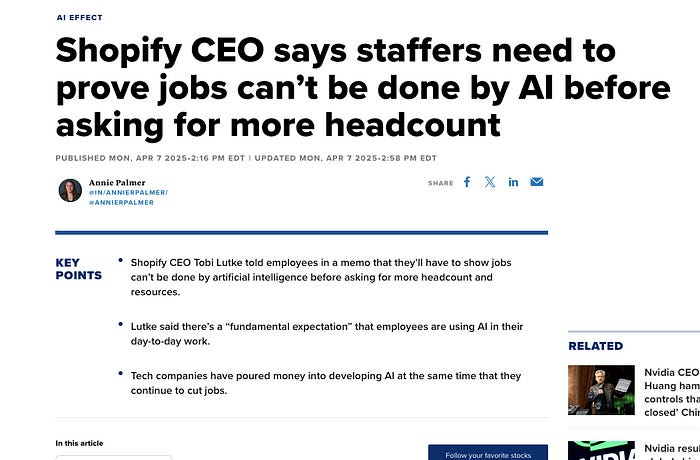Why Your Cybersecurity Job May Not Exist in 5 Years
How to Prepare for the AI-Powered Future of Security, Relevance, and Reinvention

We’re at the edge of a dramatic, world-ending shift in cybersecurity.
(And yes, I know that’s how every AI article begins.)
But let’s be honest — something real is happening here.
This isn’t just another wave of tech evolution.
It’s a fundamental change in how security work is being created, delivered, and valued.
AI is moving fast — faster than most of us expected.
And in cybersecurity, that speed is exposing the limits of anything repetitive, reactive, or overly reliant on old playbooks.
Those approaches are quietly becoming obsolete.
In the next five years, AI won’t just enhance how we work — it will redefine who works, how value is created, and what skills are indispensable.
According to recent insights, the smartest AI models are already outperforming 85% of humans. By 2026, that number is projected to hit 99.9%.
Already, the CEO of Shopify has declared that no new headcount will be approved unless you can prove AI can’t do the job.
That’s not hyperbole — it’s the new hiring policy.

And across tech, thousands of roles are being frozen, reassessed, or replaced under “AI efficiency mandates.”
So where does that leave cybersecurity?
Exactly where it should be — leading the adaptation.
The Era of “Boring Work” Is Over
Any role driven by checklists, decision trees, or rote response patterns — like signature tuning, control checklists, compliance audits — is vulnerable to being automated.
But here’s the opportunity: cybersecurity is also becoming one of the most strategically vital disciplines in the AI-powered future.
Why? Because AI is not just a tool — it’s also an attack surface, a supply chain, and a vector.
To thrive, cybersecurity professionals must stop operating like checkers and start playing chess.
That means becoming thinkers, risk translators, and specialists with taste — the ability to spot subtle dangers, shape better decisions, and guide intelligent systems.
What’s Changing in Cybersecurity (And Why It Matters)
1. Automation Will Swallow the Baseline
We are already seeing Tier 1 SOC analysis, phishing response, log parsing, and even parts of pentesting being handed off to AI. What once took teams now takes tools.
What to do
Focus on strategic, creative, or cross-disciplinary domains: threat modeling, adversary simulation, AI model security, data governance, and business-aligned risk management.
2. Security Teams Will Shrink, but Expectations Will Grow
Just like some startups are scaling to $30M ARR with three people and AI, the modern cybersecurity team is evolving into lean, specialized squads empowered by intelligent systems.
What to do
Be a multiplier. Learn how to translate complex security topics for executives, work across cloud/data/legal boundaries, and drive impact in lean teams.
3. Agentic AI and the Rise of One-Person Companies
Agentic AI tools — and specifically the Model Context Protocol (MCP) — are letting anyone build, scale, and launch complex digital products by chaining together AI decisions, memory, and actions. This is creating a new category of builders: the cybersecurity-enabled creator.
We’re seeing the rise of one-person businesses that monetize cybersecurity expertise through scalable offers: courses, tools, assessments, automations, and more. MCP lowers the barrier to entry and allows individuals — not just companies — to create sophisticated, secure AI agents.
What to do
Learn how MCP works. Understand the risks of prompt injection, token leakage, memory hijacking, and multi-agent compromise. Then, position yourself as someone who can secure these systems — or build your own.
4. The Independent Security Specialist Will Thrive
As traditional org charts flatten and permanent headcount becomes rare, companies will look to fractional experts — vCISOs, LLM red teamers, data protection auditors, AI security consultants — to solve targeted problems.
What to do
Build a niche. Publish. Productize. Package your expertise into offerings that solve very specific, urgent problems — and do it in a way that scales.
The Cybersecurity Leverage Stack: A Framework for the Future
This transformation requires not just new tools, but a new way of thinking.
Use this four-part Cybersecurity Leverage Stack to guide your evolution:
1. Knowledge: Become an expert in one intersectional domain — like GenAI misuse, quantum-era crypto, or secure agent design.
2. Offers: Solve real problems, clearly. Example: “I help SaaS companies secure GenAI features in 30 days without blocking product teams or failing compliance audits.”
3. Systems: Use AI tools to automate the dull stuff — reporting, scripting, analysis — and free up time for deep, creative work.
4. Scale: Use the internet as your force multiplier. Write, teach, speak. Reach others with your expertise instead of waiting for job titles to do it.
The Age of “Yes, But…” Has Arrived
AI will do the legwork. But you are still responsible for the judgment.
The world no longer needs professionals who can recite cybersecurity frameworks by heart.
It needs professionals who can say: “Yes, this meets policy — but here’s the deeper risk.” “Yes, the AI works — but here’s what it missed.”
That’s what makes you irreplaceable.
If you’re doing boring, repeatable work — it’s going to be automated. But if you develop rare insight, use AI to amplify your reach, and focus on solving meaningful problems, you won’t just survive this shift.
You’ll own it.
Good luck !



